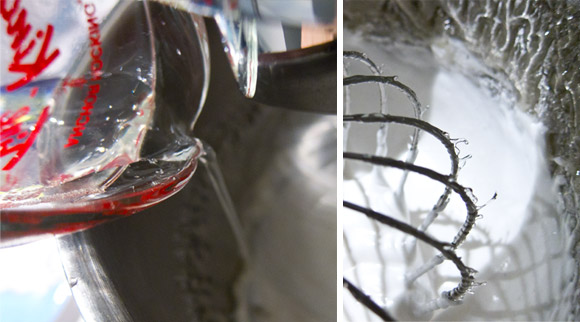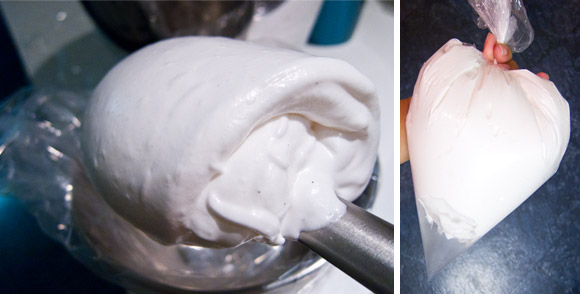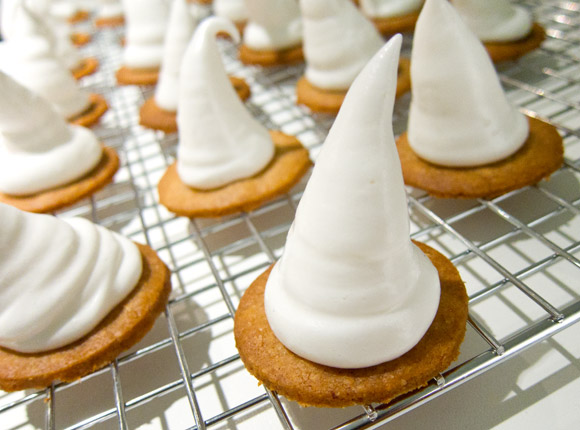 It’s not often I need to make marshmallows – but I do enjoy eating them. This time, though, I needed a batch for those Witches’ Hats – and the Bouchon Bakery cookbook handily provides their recipe. Their version is not too sweet and fairly straight-forward to make. Except I’m really terrible at this marshmallow making. Still, I managed a respectable batch for both the Witches’ Hats and the regular squares. If I can do it…
It’s not often I need to make marshmallows – but I do enjoy eating them. This time, though, I needed a batch for those Witches’ Hats – and the Bouchon Bakery cookbook handily provides their recipe. Their version is not too sweet and fairly straight-forward to make. Except I’m really terrible at this marshmallow making. Still, I managed a respectable batch for both the Witches’ Hats and the regular squares. If I can do it…
Vanilla marshmallow recipe is excerpted from Bouchon Bakery by Thomas Keller and Sebastien Rouxel (Artisan Books) with permission from the publisher. Copyright © 2012. My annotations are in blue.
Vanilla Marshmallows
Marshmallows may seem mysterious and complex, but they’re really easy—nothing more than meringue set with gelatin. If you can make a meringue, you can make your own marshmallows. They’re playful and fun, and they can be made in different flavors. We make lemon, raspberry, and vanilla marshmallows, but you could add jams or pistachio paste for different flavors (add 15 to 20 percent of the weight of the egg whites and sugar).
Makes about 4 dozen 1-inch marshmallows (250 grams/8.8 ounces)
- ½ cup (58 grams) powdered sugar
- ½ cup (64 grams) cornstarch
- 4 sheets (9.6 grams) silver leaf gelatin – 1 packet of knox
- ¼ cup + 2 tablespoons (87 grams) egg whites
- ¼ vanilla bean, split lengthwise
- 1 cup + 2 tablespoons (225 grams) Granulated sugar
- ½ cup (112 grams) water
- 2 ½ tablespoons (50 grams) light corn syrup
Notes: You’ll need an 8-inch-square baking pan, an 8-inch-square piece of acetate, and a Thermapen or other candy thermometer.
Mix the powdered sugar and cornstarch together. Line the baking pan with plastic wrap and sprinkle the plastic wrap generously with the powdered sugar mixture; set the remainder aside.
Place the gelatin in a bowl of ice water to soften.
Spray one side of the piece of acetate with nonstick spray; set aside.
Remove the gelatin from the water and squeeze out excess water. Place the gelatin in a small metal bowl set over a small pot of simmering water and melt it (do not let it simmer), then reduce the heat and keep it warm.
Meanwhile, place the egg whites in the bowl of a stand mixer fitted with the whisk attachment. Scrape the seeds from the vanilla bean and add the seeds to the egg whites.
Combine the granulated sugar, water, and corn syrup in a large saucepan and bring to a simmer over medium-high heat, stirring to dissolve the sugar, then simmer for about 5 minutes, until the syrup reaches 250°F/121.1°C. It took a while to get here. I had to set it on high. Then things went quite quickly after 250°.
Letting the syrup continue to cook, turn the mixer to medium speed. The goal is to have the whites at medium peaks when the syrup reaches 281° to 284°F/138° to 140°C. Should the whites reach stiff peaks before the syrup reaches the proper temperature, reduce the mixer speed to the lowest setting.

Putting in the gelatin. Lots of spikey sugar bits after I was done, but it didn’t seem to affect the results adversely.
When the syrup reaches 281° to 284°F/138° to 140°C, remove it from the heat. Turn the mixer to medium speed and slowly add the syrup to the egg whites, pouring it between the side of the bowl and the whisk. Start with a slow stream – about the size of a straw and once the mixture has tempered up a bit, you can go faster. Pour in the gelatin, increase the speed to medium-high, and mix for about 5 minutes, until the mixture is thickened, glossy, and warm but not hot. If you find your mixture watery, keep beating. It should firm up in the allotted 5 minutes.

Marshmallow piping – transferring into a bag for the Witches’ Hats recipe.
Spray a spatula with nonstick spray. Spread the marshmallow evenly in the prepared pan. Top with the acetate, sprayed side down, and gently press it against the marshmallow to make the top perfectly smooth.
Set a piece of parchment paper larger than the marshmallow on a large cutting board.
Remove the sheet of acetate. Coat the top of the marshmallow with some of the reserved powdered sugar mixture. Flip the marshmallow onto the parchment paper, remove the plastic wrap, and sprinkle with more of the powdered sugar mixture as necessary.
It can be difficult to cut marshmallows evenly. Spray a large chef’s knife with nonstick spray and trim the sides of the marshmallow square, then cut into 1-inch cubes (or other shapes), using a ruler as a guide (see Note to Professionals). Clean and respray the knife before each cut. If the marshmallows are sticky when you separate them, dust them lightly with additional powdered sugar mixture.
The marshmallows can be stored in a covered container at room temperature for up to 3 days.
Excerpted from Bouchon Bakery by Thomas Keller and Sebastien Rouxel (Artisan Books) with permission from the publisher. Copyright © 2012.

Pipe a cone of marshmallow in the centre of the cookie. Leave about 1/2″ for the hat’s brim. I failed at reading the first time around.
